Physics - Magnetism and Electromagnetism
1/47
There's no tags or description
Looks like no tags are added yet.
Name | Mastery | Learn | Test | Matching | Spaced |
|---|
No study sessions yet.
48 Terms
Like poles…
Repel
Opposite poles…
Attract
3 Magnetic Materials
Iron
Cobalt
Nickel
Why is steel also magentic?
Because it is a ferrous (containing iron) alloy:
Steel = Iron + Carbon
Magnets and Magnetic Materials…
Attract
Magnetically Hard
A substance that can be permanently magnetised
Magnetically Soft
A substance that can only be temporarily magnetised
Magnetic Field Lines
Show the direction and shape of a magnetic field
Magnetic Field Line Rules (for drawing)
Field lines never cross
The density of field lines gives an indication of the magnetic field strength
Magnetic field lines always point towards the south pole
Magnetic field lines always point away from the north pole
What happens to some substances if they are placed in a magnetic field?
They can become magnetic
Dipole Field
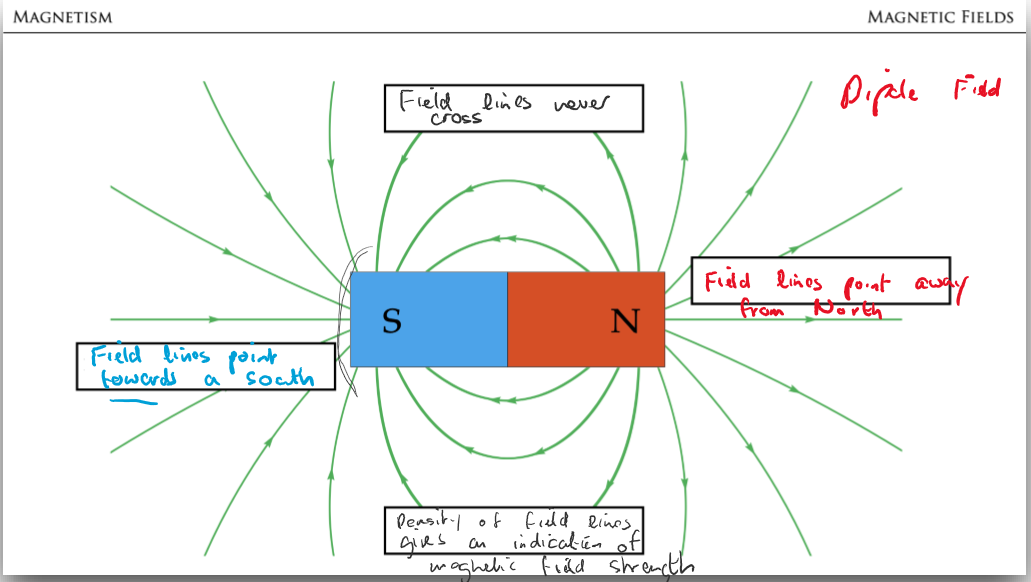
Uniform Field
Field lines are:
Straight
Equally spaced
Point from North to South

What is created when an electric current flows through a conductor?
A Magnetic Field
Construction of an Electromagnet
By winding the wire into a coil we can strengthen the magnetic field by concentrating the field lines
If this wire is wound around a soft magnet, such as an iron, then an electromagnet is made (see the electromagnet diagram below)
The electromagnet is magnetic only when current flows through the wire

How to increase the strength of an electromagnet
Increasing the current in the coil
Adding more turns to the coil
How to reverse the magnetic field
The field can be reversed by reversing the direction of the current
However, bar magnets are always magnetic, unlike electromagnets
Magnetic field pattern in a: straight wire
The magnetic field is made up of concentric circles
A circular field pattern indicates that the magnetic field around a current-carrying wire has no poles
As the distance from the wire increases the circles get further apart
This shows that the magnetic field is strongest closest to the wire and gets weaker as the distance from the wire increases
The right-hand thumb rule can be used to work out the direction of the magnetic field
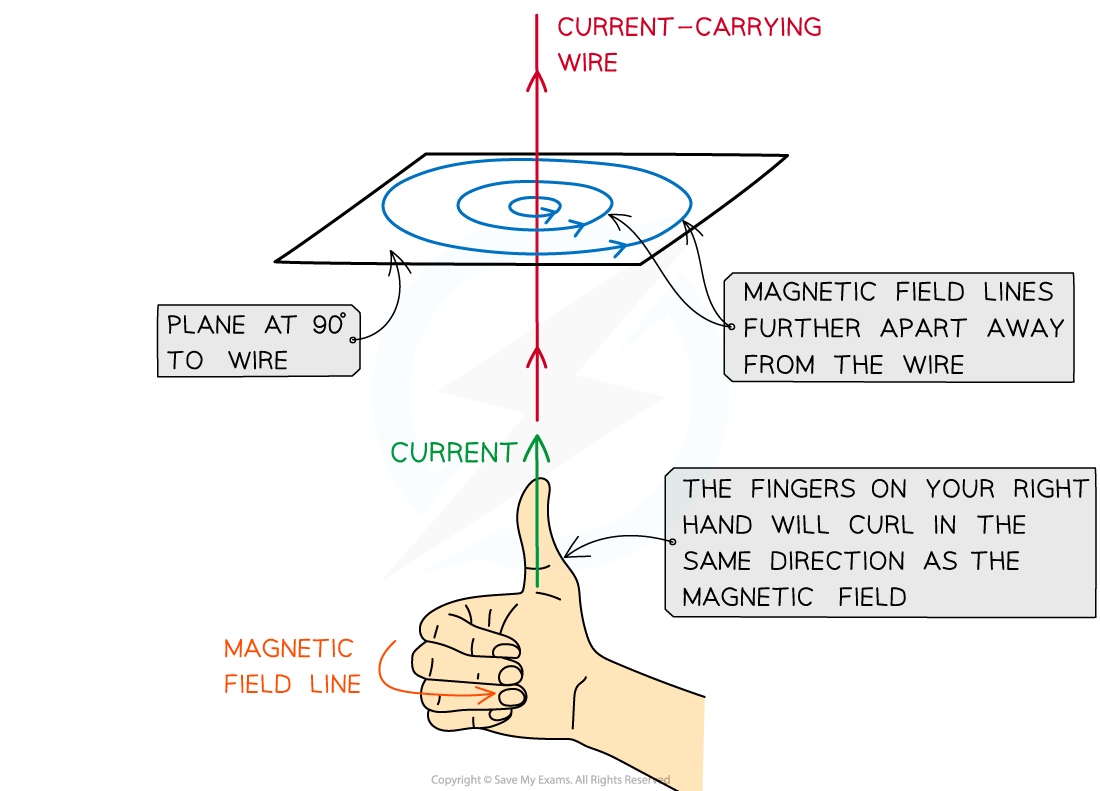
Magnetic field pattern in a: flat circular coil
When a wire is looped into a coil, the magnetic field lines circle around each part of the coil, passing through the centre of it

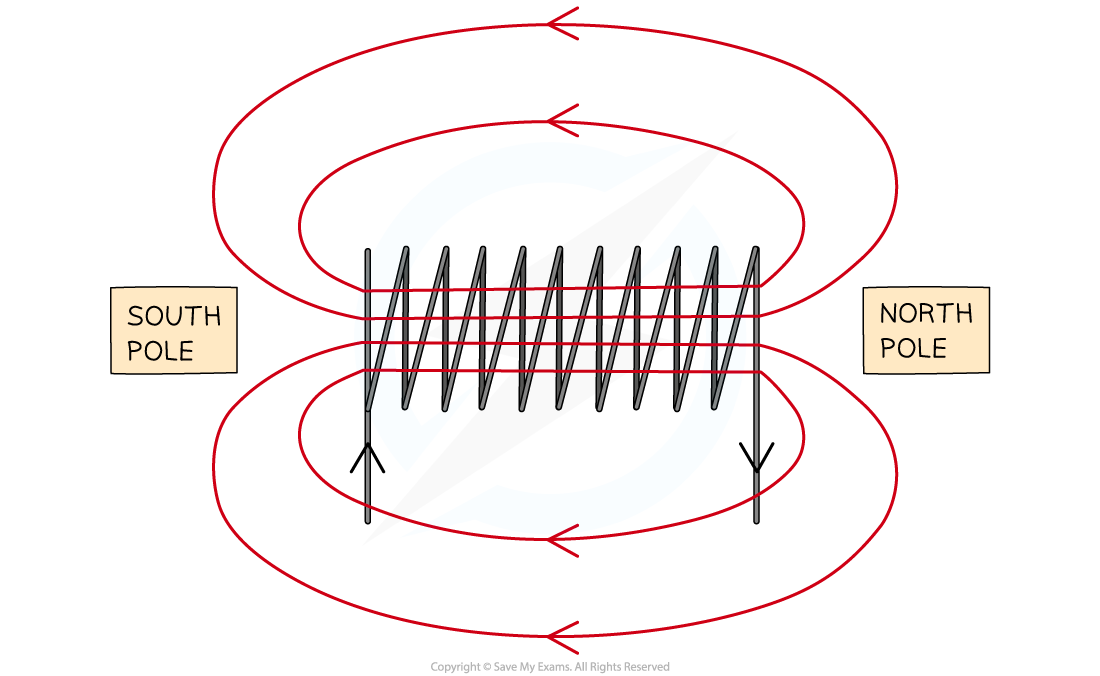
What happens when a current-carrying wire is placed in a magnetic field?
it will experience a force if the wire is perpendicular: This is because the magnetic field exerts a force on each individual electron flowing through the wire
What can be used to predict the direction of the resulting force when a wire carries a current perpendicular to a magnetic field?
Flemming’s left hand rule
Flemming’s Left-Hand Rule

The motor effect occurs when:
A wire with current flowing through it is placed in a magnetic field and experiences a force
This effect is a result of two interacting magnetic fields
One is produced around the wire due to the current flowing through it
The second is the magnetic field into which the wire is placed, for example, between two magnets
As a result of the interactions of the two magnetic fields, the wire will experience a force
When no current is passed through a conductor in a magnetic field, however, it will experience no force

D.C Motor
The motor effect can be used to create a simple d.c. electric motor
The force on a current-carrying coil is used to make it rotate in a single direction
The simple D.C. motor consists of a coil of wire (which is free to rotate) positioned in a uniform magnetic field
The coil of wire, when horizontal, forms a complete circuit with a cell
The coil is attached to a split ring (a circular tube of metal split in two)
This split ring is connected in a circuit with the cell via contact with conducting carbon brushes

Forces on the horizontal coil in a D.C. motor
Forces acting in opposite directions on each side of the coil, causing it to rotate. The split ring connects the coil to the flow of current
Current flowing through the coil produces a magnetic field
This magnetic field interacts with the uniform external field, so a force is exerted on the wire
Forces act in opposite directions on each side of the coil, causing it to rotate:
On the blue side of the coil, current travels towards the cell so the force acts upwards (using Fleming's left-hand rule)
On the black side, current flows away from the cell so the force acts downwards
Once the coil has rotated 90°, the split ring is no longer in contact with the brushes
No current flows through the coil so no forces act
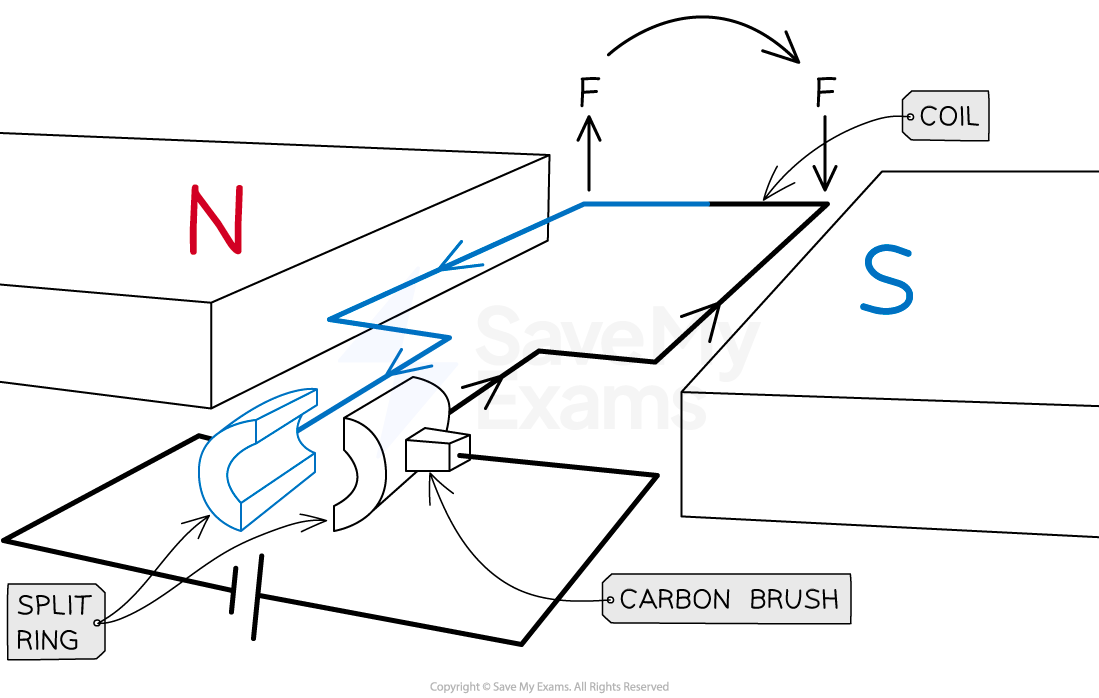
Coil in the vertical position
No force acts on the coil when vertical, as the split ring is not in contact with the brushes
Even though no force acts, the momentum of the coil causes the coil to continue to rotate slightly
The split ring reconnects with the carbon brushes and current flows through the coil again
Now the blue side is on the right and the black side is on the left
Current still flows toward the cell on the left and away from the cell on the right, even though the coil has flipped
The black side of the coil experiences an upward force on the left and the blue side experiences a downward force on the right
The coil continues to rotate in the same direction, forming a continuously spinning motor

Forces on the coil when rotated 180°
Even though the coil has flipped, current still flows anticlockwise and the forces still cause rotation in the same direction
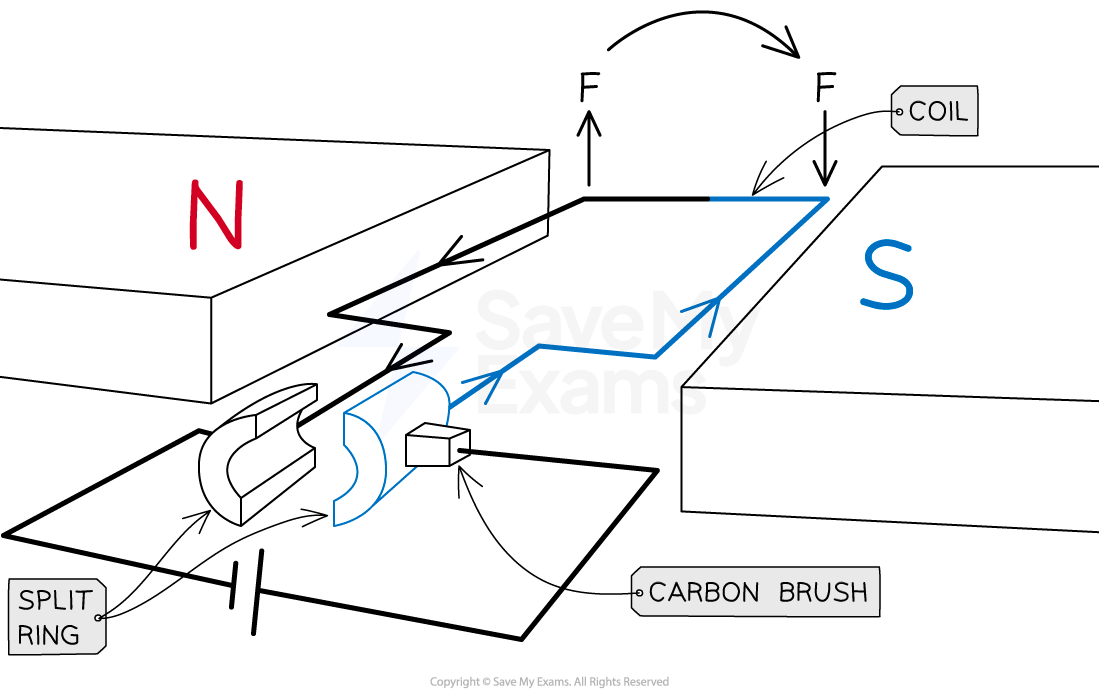
The speed at which the coil rotates can be increased by: (D.C Motor)
Increasing the current
Increasing the strength of the magnetic field
The direction of rotation of coil in the D.C. motor can be changed by
Reversing the direction of the current
Reversing the direction of the magnetic field by reversing the poles of the magnet
The force supplied by the motor can be increased by:
Increasing the current in the coil
Increasing the strength of the magnetic field
Adding more turns to the coil
Loudspeakers
An alternating current passes through the coil of the loudspeaker
This creates a changing magnetic field around the coil
As the current is constantly changing direction, the direction of the magnetic field will be constantly changing
The magnetic field produced around the coil interacts with the field from the permanent magnet
The interacting magnetic fields will exert a force on the coil
The direction of the force at any instant can be determined using Fleming’s left-hand rule
As the magnetic field is constantly changing direction, the force exerted on the coil will constantly change direction
This makes the coil oscillate
The oscillating coil causes the speaker cone to oscillate
This makes the air oscillate, creating sound waves
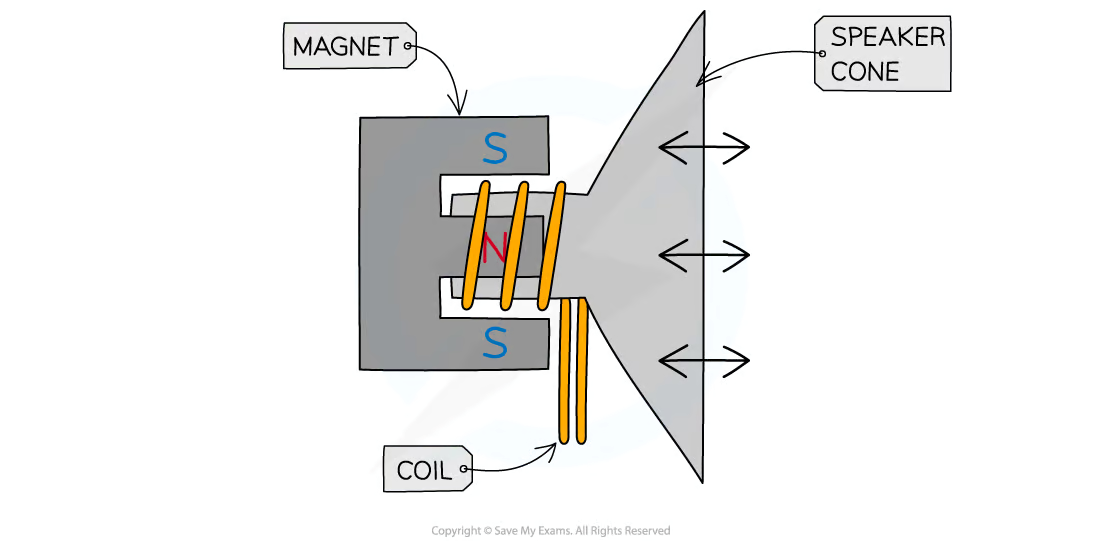
The generator effect (electromagnetic induction)
When a voltage is induced in a conductor or a coil when it moves through a magnetic field or when a magnetic field changes through it
This is done by the conductor or coil cutting through the magnetic field lines of the magnetic field
Difference between the motor effect and the generator effect
In the motor effect, there is already a current in the conductor which experiences a force
In the generator effect, there is no initial current in the conductor, but one is induced (created) when it moves through a magnetic field
Generating a potential difference
A potential difference will be induced in the conductor if there is relative movement between the conductor and the magnetic field

The size of the induced potential difference is determined by:
The speed at which the wire, coil or magnet is moved
The number of turns on the coils of wire
The size of the coils
The strength of the magnetic field
The direction of the induced potential difference is determined by:
The orientation of the poles of the magnet
The speed at which the wire, coil or magnet is moved:
Increasing the speed will increase the rate at which the magnetic field lines are cut
This will increase the induced potential difference
The number of turns on the coils in the wire:
Increasing the number of turns on the coils for a given length in the wire will increase the potential difference induced
Reducing the length of wire but maintaining the number of turns will also increase the potential difference induced
This is because each coil will cut through the magnetic field lines and the total potential difference induced will be the result of all the coils cutting the magnetic field lines
The size of the coils:
Increasing the area of the coils will increase the potential difference induced
This is because there will be more wire to cut through the magnetic field lines
The strength of the magnetic field:
Increasing the strength of the magnetic field will increase the potential difference induced
The orientation of the poles of the magnet:
Reversing the direction in which the wire, coil or magnet is moved
Structure of a Transformer
A basic transformer consists of:
A primary coil
A secondary coil
An iron core
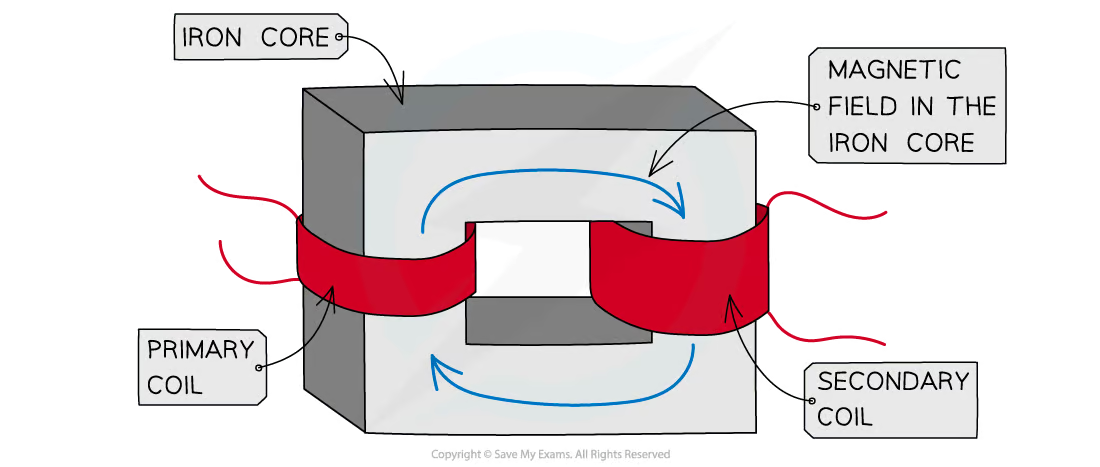
What do Transformers do?
Change the size of an alternating current by having different numbers of turns on the input and output sides
Step Down Transformers use
For the domestic use of electricity, the voltage must be much lower
This is done by stepping down by the voltage using a step-down transformer
These are placed before buildings
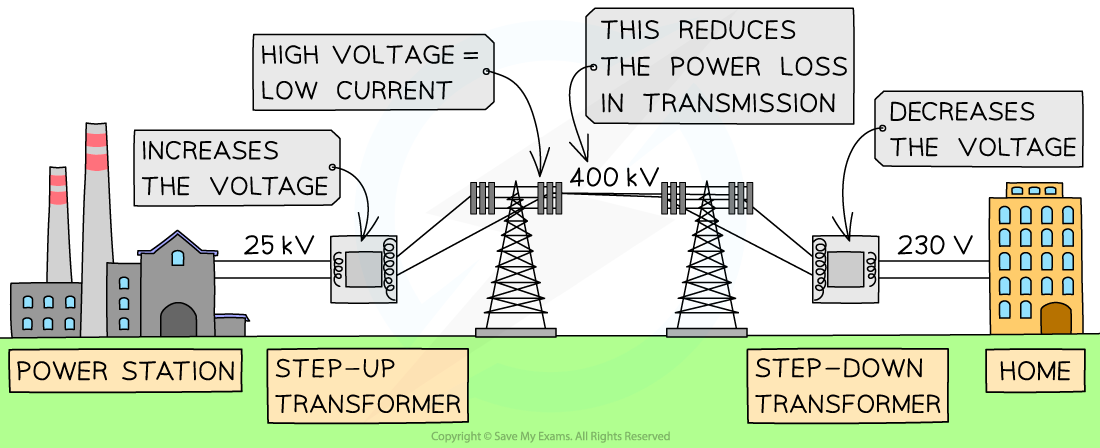
Step Up Transformers use
When electricity is transmitted over large distances, the current in the wires heats them, resulting in energy loss
The electrical energy is transferred at high voltages from power stations
It is then transferred at lower voltages in each locality for domestic uses
The voltage must be stepped up by a step-up transformer
These are placed after the power station

Equation that relates input (primary) and output (secondary) and the turns ratio for a transformer
input (primary) voltage / output (secondary) voltage = primary turns / secondary turns
Equation relating input and output power for 100% efficiency
Vp Ip = Vs Is